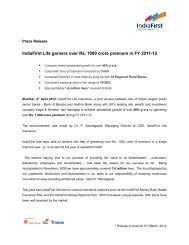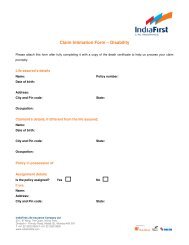Instructions for using Employee Self Service portal 1) Copy the ...
Instructions for using Employee Self Service portal 1) Copy the ...
Instructions for using Employee Self Service portal 1) Copy the ...
Create successful ePaper yourself
Turn your PDF publications into a flip-book with our unique Google optimized e-Paper software.
<strong>Instructions</strong> <strong>for</strong> <strong>using</strong> <strong>Employee</strong> <strong>Self</strong> <strong>Service</strong> <strong>portal</strong><br />
1) <strong>Copy</strong> <strong>the</strong> following link on <strong>the</strong> Address bar of <strong>the</strong> Internet Browser<br />
http://sequelgroup.co.in/ESS/Login.aspx<br />
2) Login Screen
3) Profile Screen:- Following web page will appear once you login <strong>using</strong> your company, username and password.
4) INVESTMENT DECLARATION SCREEN :- Following screen will appear when you click on<br />
INVESTMENT DECLARATION link.
<strong>Instructions</strong> <strong>for</strong> updating Investment declaration and flexi option on ESS<br />
Investment Declaration<br />
1. <strong>Employee</strong>’s In<strong>for</strong>mation<br />
Under employee’s in<strong>for</strong>mation employee has to update <strong>the</strong> following<br />
a. Number of children studying in school<br />
b. <strong>Employee</strong> Permanent Account Number (Only if incorrect PAN is displaying on <strong>the</strong> top)<br />
c. Mobile Number (mandatory)<br />
2. Investment Declaration<br />
Under Investment declaration employee has to fill in <strong>the</strong> amount <strong>the</strong>y were planning to invest under<br />
different investments plans in financial year 2012-2013 (i.e. from April 1, 2012 to March 31, 2013). Brief<br />
details of different investment plans along with <strong>the</strong>ir limits are given below <strong>for</strong> your easy understanding.<br />
a. Deduction in respect of various investments made (Sec. 80C) – Under this head deduction will made<br />
available in respect of various investments made by <strong>the</strong> employee. Maximum deduction available is<br />
Rs.1,00,000. Following investments are eligible <strong>for</strong> deduction.<br />
i. Life insurance premium paid on policy of self, spouse, children. (max limit is 20 % of sum<br />
assured)<br />
ii. Jeevan Suraksha premium paid <strong>for</strong> self, spouse, children<br />
iii. Unit Linked Insurance Plan (ULIP)<br />
iv. Mutual Fund (MF)<br />
v. ELSS<br />
vi. National Saving Certificates<br />
vii. Public Provident Fund (PPF)<br />
viii. 5 years Fixed Deposit<br />
ix. 5 years Post Office Deposit<br />
x. Tuition Fees <strong>for</strong> any two children which includes tuition fees, term fees, etc. and which does<br />
not includes development fees, donation, payment of similar nature.<br />
xi. Ho<strong>using</strong> Loan principal repayment<br />
xii. Stamp Duty / Registration paid <strong>for</strong> purchase of property.<br />
b. Medical Insurance Premium (Health Insurance Plan) (Sec. 80D) – Insurance premium paid <strong>for</strong> self,<br />
spouse and dependant child during financial year 2012-2013 will be eligible <strong>for</strong> deduction from<br />
taxable income. Max deduction available is Rs.15,000. Additional up to Rs.15,000 can be claimed<br />
as deduction if such premium paid is towards dependant parents. Additional up to Rs.15,000 can be<br />
read as Rs.20,000 if such premium paid is towards senior parents.
c. Deduction in respect of maintenance including medical treatment of a dependent being a person<br />
with disability (Sec. 80DD) - <strong>Employee</strong> has incurred an expenditure <strong>for</strong> <strong>the</strong> medical treatment of a<br />
dependant person with disability. <strong>Employee</strong> has to furnish a copy of <strong>the</strong> certificate issued by <strong>the</strong><br />
medical authority in Form No. 10-IA. Fixed deduction of Rs.50,000 can be claimed from taxable<br />
income. Higher deduction of Rs.1,00,000 shall be allowed where such dependent is a person with<br />
severe disability having disability of 80 percent or more. Persons with Autism, Cerebral Palsy,<br />
Mental retardation, multiple disabilities, etc. will be eligible.<br />
d. Deduction in respect of repayment of loan taken <strong>for</strong> higher studies (Sec. 80E) – Repayment of<br />
interest on loan taken <strong>for</strong> pursuing higher education of self, spouse and dependant children will be<br />
eligible <strong>for</strong> deduction without any limit. This deduction is available in <strong>the</strong> year in which employee<br />
starts paying interest and 7 immediately succeeding years (or until <strong>the</strong> above interest is paid in full,<br />
whichever is earlier). Loan must be taken from any bank, financial institution.<br />
e. Deduction in case of a person with disability (Sec. 80U) – <strong>Employee</strong> suffering 40 percent or more<br />
than 40 percent of any disability i.e. blindness, low vision, leprosy-cured, hearing impairment,<br />
locomotor disability, mental retardation, mental illness, autism, cerebral palsy and multiple disability<br />
will be eligible <strong>for</strong> deduction. <strong>Employee</strong> has to furnish a copy of <strong>the</strong> certificate (in Form No. 10-IA)<br />
issued by medical authority. Fixed deduction of Rs.50,000 is available. Higher deduction of<br />
Rs.1,00,000 is allowed in respect of a person with severe disability (i.e. having any disability of 80<br />
percent or above).<br />
3. Rent Declaration<br />
Rent declaration has to provided by those employees who are paying rent to <strong>the</strong>ir landlord of <strong>the</strong> property<br />
where <strong>the</strong>y resides. <strong>Employee</strong>s taking benefit of ho<strong>using</strong> interest cannot take <strong>the</strong> benefit of rent<br />
exemption if both <strong>the</strong> property is in same city, provided <strong>the</strong>y are staying in rented house as <strong>the</strong>ir own<br />
house is not ready to use. <strong>Employee</strong>s paying rent above Rs.15,000 per month should also provide PAN<br />
of landlord, else <strong>the</strong> same will not get considered <strong>for</strong> rent exemption.<br />
4. Details of Income / (loss) from o<strong>the</strong>r than salary<br />
a. Interest on hosing loan should be shown under income from house property. Maximum limit is<br />
Rs.1,50,000 where <strong>the</strong> loan is taken <strong>for</strong> construction or purchase of property on or after April 1,<br />
1999 else Rs.30,000.<br />
b. Interest on securities, Interest on Fixed Deposits, NSC interest accrued, o<strong>the</strong>r income should be<br />
shown separately under respective heads and also TDS deducted on <strong>the</strong> same should be shown<br />
separately under TDS deduction head, so that proper tax can get deducted from salary income.
Flexi Pay Option<br />
<strong>Employee</strong> has an option to choose <strong>the</strong> various heads as per <strong>the</strong>ir convenience as salary. There are fixed<br />
components as well as flexi components in <strong>the</strong>ir CTC. Various heads are explained to understand <strong>the</strong><br />
taxability of <strong>the</strong> same.<br />
1. Fixed Components – These are fixed components and employees does not have option to<br />
change <strong>the</strong> amount under <strong>the</strong>se heads<br />
a. Basic – Basic is 40% of CTC and is taxable. <strong>Employee</strong> cannot change <strong>the</strong> same.<br />
b. HRA – HRA is 50% of Basic and <strong>the</strong> least of <strong>the</strong> following three is exempt only if rent declaration is<br />
provided<br />
- Actual HRA received<br />
- 50% of Basic in case of rented property is in metro city (i.e. Mumbai, Delhi, Chennai, Kolkata)<br />
else 40% of Basic<br />
- Rent paid less 10% of Basic<br />
c. Gratuity – Gratuity is 4.81% of Basic.<br />
d. Statutory PF – Provident Fund is 12% of Basic and is eligible <strong>for</strong> deduction from taxable income<br />
under section 80C under <strong>the</strong> maximum ceiling of Rs.1,00,000. Employer’s contribution to PF up<br />
to 12% of Basic is also exempt. Above 12 % of Basic is taxable. If <strong>the</strong> employee withdraws <strong>the</strong><br />
entire amount of PF at <strong>the</strong> time of leaving <strong>the</strong> organization be<strong>for</strong>e 5 years <strong>the</strong>n <strong>the</strong> entire amount is<br />
taxable. After 5 years <strong>the</strong> entire amount (both employee and employer contribution) including<br />
interest on <strong>the</strong> same is tax free provided <strong>the</strong> same is upto 12 % of Basic.<br />
e. Medical Reimbursement – Medical reimbursement is Rs.15,000 per annum to meet <strong>the</strong> regular<br />
medical expenses and <strong>the</strong> same is tax free if bills <strong>for</strong> <strong>the</strong> same is produced to <strong>the</strong> employer else is<br />
taxable.<br />
f. Education allowance - Education allowance is Rs.2,400 per annum. The amount exempt is<br />
limited to Rs.100 per month per child up to a maximum of two children. For availing benefit of <strong>the</strong><br />
same employee has to declare <strong>the</strong> number of children studying in <strong>the</strong> investment declaration<br />
personal in<strong>for</strong>mation section.<br />
g. Special allowance – Special allowance is <strong>the</strong> balancing figure after employee opts <strong>for</strong> flexi pay and<br />
is taxable.
2. Flexible Components – These are flexible components and employees have option to<br />
change <strong>the</strong> amount under <strong>the</strong>se heads<br />
a. Food Cards – <strong>Employee</strong> of all grades can opt <strong>for</strong> food coupons up to Rs.18,000 per annum which<br />
will be exempted from tax.<br />
b. Superannuation - <strong>Employee</strong> of all grades can opt <strong>for</strong> superannuation up to 12% of Basic.<br />
Employer’s contribution to this fund will be tax free in <strong>the</strong> hands of an employee to <strong>the</strong> extent of<br />
Rs.1,00,000 per annum. Employers contribution over and above Rs.1,00,000 is taxable in <strong>the</strong><br />
hand of employees. It is exempt at <strong>the</strong> time of actual receipt from <strong>the</strong> fund.<br />
c. Leave Travel assistance – <strong>Employee</strong> can opt <strong>for</strong> leave travel assistance up to Rs.50,000 or<br />
Rs.1,00,000 per annum depending on his grade. LTA extended <strong>for</strong> going anywhere in India along<br />
with his family is exempt on <strong>the</strong> basis of provisions given below. Family includes spouse, children,<br />
parents, bro<strong>the</strong>rs and sisters who are wholly dependent on employee. <strong>Employee</strong> has to submit<br />
proofs of actual expenditure incurred on such journeys. Expenditure incurred on fare is allowed.<br />
No o<strong>the</strong>r expenditure like scooter/taxi charges at both ends, porterage expenses and<br />
lodging/boarding expenses will be eligible. <strong>Employee</strong> claiming LTA without <strong>the</strong> proofs will be<br />
taxable.<br />
- Where journey is per<strong>for</strong>med by Air - Amount of economy class air fare of <strong>the</strong> national carrier<br />
by <strong>the</strong> shortest route or <strong>the</strong> amount spent, whichever is less or<br />
- Where journey is per<strong>for</strong>med by rail - Amount of 1 st A/C rail fare by <strong>the</strong> shortest route or amount<br />
spent, whichever is less or<br />
- Where journey is per<strong>for</strong>med by any o<strong>the</strong>r mode - Amount of 1 st A/C rail fare by <strong>the</strong> shortest<br />
route or amount spent, whichever is less<br />
- Only 2 journeys in a block of 4 calendar years is exempt and <strong>the</strong> current block is 2010-2013<br />
(i.e. January 1, 2010 to December 31, 2013).<br />
d. Telephone Reimbursement – Telephone reimbursement is up to Rs.30,000, Rs.20,000 or<br />
Rs.9,600 per annum depending on <strong>the</strong> grades of <strong>the</strong> employee to meet <strong>the</strong> expenditure of landline<br />
telephone at home. This is tax free provided employee provides <strong>the</strong> bills <strong>for</strong> <strong>the</strong> same. <strong>Employee</strong><br />
has to provide <strong>the</strong> bills of <strong>the</strong> same landline number through out <strong>the</strong> financial year in <strong>the</strong> name of<br />
self, spouse or parents of <strong>the</strong> employee. Only land line phone bills will be accepted <strong>for</strong> exemption<br />
purpose else <strong>the</strong> same will be treated as taxable.<br />
e. Car Fuel reimbursement – Fuel reimbursement is up to Rs.28,800 per annum depending on <strong>the</strong><br />
grades of employee. It is tax free provided employee provides <strong>the</strong> bills <strong>for</strong> <strong>the</strong> same. Bills can be<br />
of fuel, insurance of <strong>the</strong> vehicle, maintenance. <strong>Employee</strong> also has to provide <strong>the</strong> Registration<br />
<strong>Copy</strong> of <strong>the</strong> vehicle which has to be in <strong>the</strong> name of self, spouse or parents of <strong>the</strong> employee.<br />
Rs.21,600 is tax free in case Cubic Capacity of <strong>the</strong> vehicle is below 1.6 CC else Rs.28,800 is<br />
exempt.
f. Driver’s Salary reimbursement – Driver’s salary reimbursement is up to Rs.10,800 per annum<br />
depending on <strong>the</strong> grades of employee. It is tax free provided employee provides vouchers of<br />
payment made to driver. <strong>Employee</strong> also has to provide <strong>the</strong> Registration <strong>Copy</strong> of <strong>the</strong> vehicle which<br />
has to be in <strong>the</strong> name of self, spouse or parents of <strong>the</strong> employee.<br />
g. Conveyance allowance – Conveyance allowance is Rs.9,600 per annum to all grades of<br />
employee. The same is tax free. It will be given to those employees who do not opt <strong>for</strong> Car Fuel<br />
reimbursement as well as Driver’s Salary reimbursement. <strong>Employee</strong> can opt <strong>for</strong> ei<strong>the</strong>r<br />
Conveyance allowance or Fuel Reimbursement and Driver’s Salary.

















